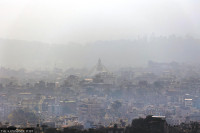Health
Focus on entry points not enough to stem monkeypox spread, experts say
While screening suspects at international airports and land crossings is crucial, authorities say, equal importance must be given to surveillance in communities.
Arjun Poudel
A few weeks ago, the health desk at the Tribhuvan International Airport sent a 26-year-old man to Sukraraj Tropical and Infectious Disease Hospital after he checked in at the airport, as he was suspected of having monkeypox infection.
But tests at the hospital found that he was infected with leprosy instead.
“We have been screening people returning from the countries that have reported monkeypox cases,” said a health worker deployed at the airport health desk. “But the problem is that cases of the viral disease have been detected in so many countries and not all who come in contact with the infected people exhibit the symptoms.”
With the spread of the viral disease in about 80 countries so far, the Ministry of Health and Population has alerted all agencies concerned, including the health desks deployed at the two international airports—in Kathmandu and Bhairahawa—and at international land crossings.
“Our health workers had suspected three monkeypox cases,” said Dr Chuman Lal Das, director at the Epidemiology and Disease Control Division. “But all three suspects tested negative for monkeypox virus at the hospital. One was infected with leprosy while the other two had chickenpox.”
Monkeypox is a rare disease caused by infection with the monkeypox virus and one in 10 infected persons can die. Most common in remote parts of central and west Africa, the disease has now been reported in at least 78 countries.
The World Health Organisation on Saturday declared the outbreak as “a public health emergency of international concern.”
An international public health emergency is different from a pandemic, like the one caused by the coronavirus.
A pandemic is a global outbreak of a virus that infects large numbers of people and causes a high number of deaths, often disrupting daily life and causing general hardship.
The UN health body says that an international public health emergency is an “extraordinary event” that poses a serious public health risk.
Covid-19 and Ebola outbreaks were also followed by such a declaration.
Experts in Nepal say that screening suspects at health desks at international airports and land crossings is not sufficient to prevent a possible outbreak of monkeypox in the country since it usually takes between five and 21 days for the first symptoms to appear and not all cases of infection can be detected at the health desks.
Monkeypox cases have been reported in neighbouring India, with which Nepal shares a long, porous border.
In India, at least four cases of monkeypox have been reported since July 15, with one case detected in capital Delhi in a man with no travel history.
Dr Bikesh Tamrakar, an epidemiologist and assistant professor at Kathmandu University, said authorities should step up overall surveillance measures to prevent community outbreak of the virus. “Not all infected people show symptoms when screened at the health desks and it is not possible to quarantine them for 21 days to know their infection status,” Tamrakar said. “That is why it is important to increase surveillance at the community level.”
More than 18,000 cases in nearly 78 countries including India have been reported so far. The number of monkeypox cases is expected to surpass 27,000 in 88 countries by August 2, according to a Reuters report.
Scientists advising the UN health agency on monkeypox say the window to stem the spread of the virus is shrinking with cases currently doubling every two weeks, raising concerns that the outbreak may peak in the next few months.
Monkeypox has been a globally neglected public health problem in parts of Africa for decades; the disease came into widespread attention after May, with countries outside Africa reporting new cases.
Doctors say symptoms of monkeypox include fever, headache, swelling, body pain, exhaustion, and itchy rashes on the face, hands, and feet.
As the disease primarily spreads through close person-to-person contact, public health experts recommend self-isolation and good hygiene practices to avoid it.
Around 10 percent of patients with monkeypox have been hospitalised in the current outbreak and five patients have died, all of them in Africa, the WHO said.
Beyond Africa, monkeypox is spreading chiefly in men who have sex with men, putting sexual health clinics on alert for new cases.
Meanwhile, the Health Ministry in Nepal said that it has developed a system to collect samples of the suspects, followed by tests in a provincial health laboratory and at the National Public Health Laboratory from where the samples will be sent to the WHO collaborating centre in India for final confirmation.
“We have also designated dermatologists serving in 14 central hospitals as focal persons,” said Dr Samir Kumar Adhikari, joint spokesperson at the Health Ministry. “We expect patients to visit a dermatologist once they have symptoms of monkeypox. The doctor will then recommend tests for infection.”
Experts, however, say that things will not be that simple wherein patients with skin rashes will go to dermatologists as expected. In cases not severe, symptoms in a monkeypox suspect may gradually recede over time without treatment but in that time period, the infected may pass on the virus to their close contacts.
On Thursday, the WHO Nepal handed over real time polymerase chain reaction test kits for monkeypox to the National Public Health Laboratory. The UN health agency said that access to monkeypox diagnostics enables Nepal’s diagnostic capacity and supports timely surveillance, case identification and strengthens containment activities.
Tamrakar, the epidemiologist, said that since monkeypox has already been detected in India, chances of its spread in Nepal is high. “What we should not forget is that every disease seen in any corner of the world has the possibility to come to Nepal due to high mobility,” he said.




 9.12°C Kathmandu
9.12°C Kathmandu













%20(1).jpg&w=300&height=200)
